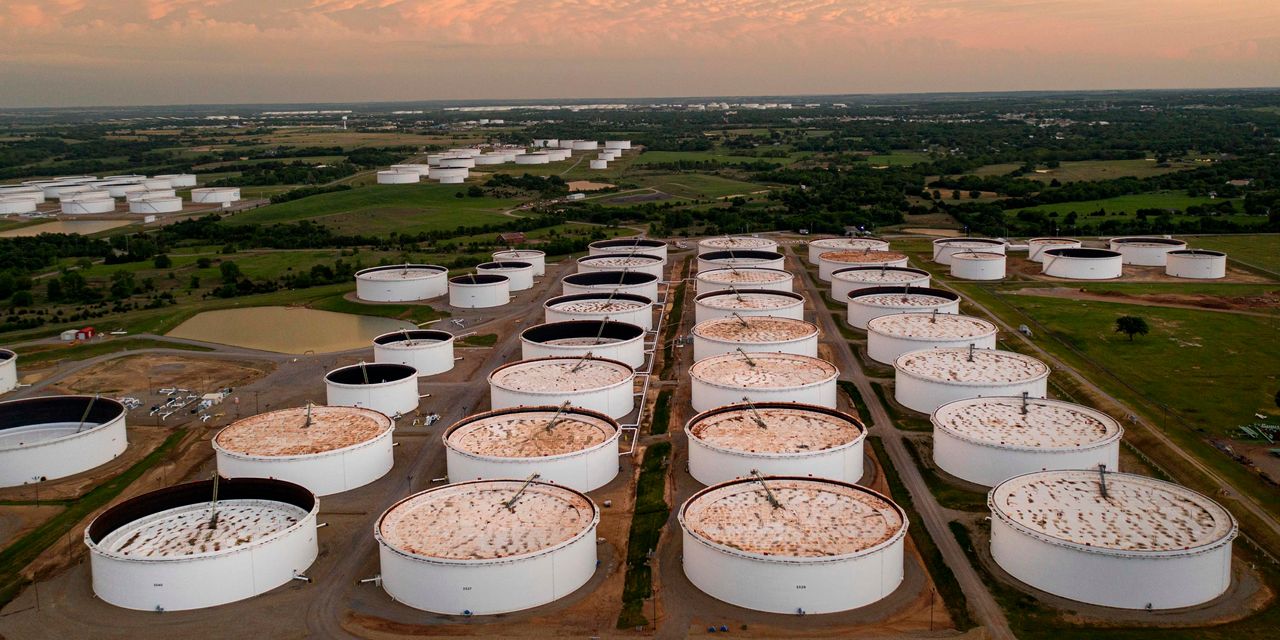U.S. oil futures eked out a gain on Thursday to hold ground at their highest settlement in about two weeks after official U.S. data reveal a third weekly fall in domestic crude inventories.
Global benchmark Brent crude, however, finished a bit lower, with oil prices, overall, having been mostly stuck in a tight trading range since early June, on the back of persistent worries over demand from China and the global economic outlook.
Price action
-
West Texas Intermediate crude for August delivery
CL00,
+2.60% CL.1,
+2.60% CLQ23,
+2.60%
rose by a penny to settle at $71.80 a barrel on the New York Mercantile Exchange, holding ground at their highest finish since June 21, according to Dow Jones Market Data. -
September Brent crude
BRN00,
-0.38% BRNU23,
-0.38% ,
the global benchmark, declined by 13 cents, or 0.2%, to settle at $76.52 a barrel on ICE Futures Europe after settling Wednesday at a two-week high. -
Back on Nymex, August gasoline
RBQ23,
+1.76%
rose 1% to $2.5438 a gallon, while August heating oil
HOQ23,
+3.27%
fell 0.6% at $2.4794 a gallon. -
August natural gas
NGQ23,
-1.76%
declined by 1.8% at $2.609 per million British thermal units.
Supply data
The Energy Information Administration on Thursday reported that U.S. commercial crude inventories fell by 1.5 million barrels for the week ended June 30. That followed back-to-back weekly declines.
On average, analysts polled by S&P Global Commodity Insights expected the report, which was released a day later than usual due to Tuesday’s Fourth of July holiday, to show a decline of 3.6 million barrels. The American Petroleum Institute reported late Wednesday that U.S. crude inventories fell by 4.4 million barrels last week, according to a source citing the data.
The EIA report also revealed weekly inventory decreases of 2.5 million barrels for gasoline and 1 million barrels for distillates. Analysts had forecast weekly decreases of 1.7 million barrels for gasoline and 700,000 barrels for distillates.
Crude stocks at the Cushing, Okla., Nymex delivery hub edged down by 400,000 barrels for the week, the EIA said, while stocks in the Strategic Petroleum Reserve fell 1.5 million barrels.
While there were draws across the board for petroleum supplies,” significant weakness in domestic crude demand is starting to weigh on those that were expecting massive crude draws by this time of the year,” said Troy Vincent, senior market analyst at DTN.
“Crude demand at U.S. refineries is down 400,000 [barrels per day] year-on-year despite the fact that refinery capacity has expanded by 250,000 bpd,” he said. “The four-week average measure of U.S. refinery utilization is now back in line with 2021 levels — when the U.S. and world was still being heavily impacted by COVID outbreaks — for the seasonal period at just 92.5%.”
Despite this weakness in refinery runs, “gasoline and diesel stocks are posting very modest draws amid continued softness in domestic product demand,” said Vincent.
Other market drivers
Crude prices posted a gain on Wednesday following an announcement this week, ahead of Tuesday’s Fourth of July holiday, by Saudi Arabia, which said it would extend its July production cut of 1 million barrels a day through August, while Russia said it would curb exports by 500,000 barrels a day. The Saudi move had been widely expected, while traders have cast doubt on Russia’s willingness to cut.
Meanwhile, worries about the economic outlook continue to limit upside, analysts said, amid disappointment over China’s economic performance since lifting COVID curbs earlier this year. Aggressive tightening by global central banks has added to worries over the global outlook.
“Fundamentals are not dictating oil prices at the moment. Instead, macro uncertainty and concerns over the China recovery are proving an obstacle to oil prices moving higher,” Warren Patterson, head of commodities strategy at ING, said in a note ahead of the EIA oil supply data. “In addition, expectations for a more hawkish U.S. Fed will certainly not be helping risk appetite.”
In related news Wednesday, Saudi Arabia raised prices for its crude to Europe and the Mediterranean and also unexpectedly lifted prices to Asia, according to Bloomberg.
Read the full article here


